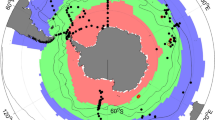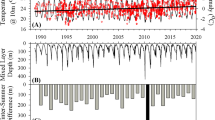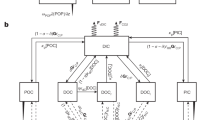Abstract
The transfer of organic carbon from the upper to the deep ocean by particulate export flux is the starting point for the long-term storage of photosynthetically fixed carbon. This ‘biological carbon pump’ is a critical component of the global carbon cycle, reducing atmospheric CO2 levels by ~200 ppm relative to a world without export flux. This carbon flux also fuels the productivity of the mesopelagic zone, including important fisheries. Here we show that, despite its importance for understanding future ocean carbon cycling, Earth system models disagree on the projected response of the global export flux to climate change, with estimates ranging from −41% to +1.8%. Fundamental constraints to understanding export flux arise because a myriad of interconnected processes make the biological carbon pump challenging to both observe and model. Our synthesis prioritizes the processes likely to be most important to include in modern-day estimates (particle fragmentation and zooplankton vertical migration) and future projections (phytoplankton and particle size spectra and temperature-dependent remineralization) of export. We also identify the observations required to achieve more robust characterization, and hence improved model parameterization, of export flux and thus reduce uncertainties in current and future estimates in the overall cycling of carbon in the ocean.
This is a preview of subscription content, access via your institution
Access options
Access Nature and 54 other Nature Portfolio journals
Get Nature+, our best-value online-access subscription
$29.99 / 30 days
cancel any time
Subscribe to this journal
Receive 12 print issues and online access
$259.00 per year
only $21.58 per issue
Buy this article
- Purchase on Springer Link
- Instant access to full article PDF
Prices may be subject to local taxes which are calculated during checkout



Similar content being viewed by others
Data availability
All CMIP6 model output used in our analysis is freely available from https://esgf-data.dkrz.de/projects/cmip6-dkrz/.Source data are provided with this paper.
References
De La Rocha, C. L. in Treatise on Geochemistry 2nd edn (ed. Elderfield, H.) 83–111 (Pergamon, 2006).
Kwon, E. Y., Primeau, F. & Sarmiento, J. L. The impact of remineralization depth on the air–sea carbon balance. Nat. Geosci. 2, 630–635 (2009).
Henson, S. A., Sanders, R. & Madsen, E. Global patterns in efficiency of particulate organic carbon export and transfer to the deep ocean. Glob. Biogeochem. Cycles 26, GB1028 (2012).
Marsay, C. M. et al. Attenuation of sinking particulate organic carbon flux through the mesopelagic ocean. Proc. Natl Acad. Sci. USA 112, 1089–1094 (2015).
Laufkötter, C. et al. Projected decreases in future marine export production: the role of the carbon flux through the upper ocean ecosystem. Biogeosciences 13, 4023–4047 (2016).
Séférian, R. et al. Tracking improvement in simulated marine biogeochemistry between CMIP5 and CMIP6. Curr. Clim. Change Rep. 6, 95–119 (2020).
Kwiatkowski, L. et al. Twenty-first century ocean warming, acidification, deoxygenation, and upper-ocean nutrient and primary production decline from CMIP6 model projections. Biogeosciences 17, 3439–3470 (2020).
Boyd, P. W., Claustre, H., Levy, M., Siegel, D. A. & Weber, T. Multi-faceted particle pumps drive carbon sequestration in the ocean. Nature 568, 327–335 (2019).
Waite, A., Fisher, A., Thompson, P. & Harrison, P. Sinking rate versus cell volume relationships illuminate sinking rate control mechanisms in marine diatoms. Mar. Ecol. Prog. Ser. 157, 97–108 (1997).
Iversen, M. H. & Lampitt, R. S. Size does not matter after all: no evidence for a size–sinking relationship for marine snow. Prog. Oceanogr. 189, 102445 (2020).
McDonnell, A. M. P. & Buesseler, K. O. Variability in the average sinking velocity of marine particles. Limnol. Oceanogr. 55, 2085–2096 (2010).
Francois, R., Honjo, S., Krishfield, R. & Manganini, S. Factors controlling the flux of organic carbon to the bathypelagic zone of the ocean. Glob. Biogeochem. Cycles 16, 1087 (2002).
Le Moigne, F. A. C., Pabortsava, K., Marcinko, C. L. J., Martin, P. & Sanders, R. J. Where is mineral ballast important for surface export of particulate organic carbon in the ocean? Geophys. Res. Lett. 41, 8460–8468 (2014).
Maerz, J., Six, K. D., Stemmler, I., Ahmerkamp, S. & Ilyina, T. Microstructure and composition of marine aggregates as co-determinants for vertical particulate organic carbon transfer in the global ocean. Biogeosciences 17, 1765–1803 (2020).
Seebah, S., Fairfield, C., Ullrich, M. S. & Passow, U. Aggregation and sedimentation of Thalassiosira weissflogii (diatom) in a warmer and more acidified future ocean. PLoS ONE 9, e112379 (2014).
Mari, X., Passow, U., Migon, C., Burd, A. B. & Legendre, L. Transparent exopolymer particles: effects on carbon cycling in the ocean. Prog. Oceanogr. 151, 13–37 (2017).
Bach, L. T. et al. An approach for particle sinking velocity measurements in the 3–400 μm size range and considerations on the effect of temperature on sinking rates. Mar. Biol. 159, 1853–1864 (2012).
Taucher, J., Bach, L. T., Riebesell, U. & Oschlies, A. The viscosity effect on marine particle flux: a climate relevant feedback mechanism. Glob. Biogeochem. Cycles 28, 415–422 (2014).
Devol, A. H. & Hartnett, H. E. Role of the oxygen-deficient zone in transfer of organic carbon to the deep ocean. Limnol. Oceanogr. 46, 1684–1690 (2001).
Laufkötter, C., John, J. G., Stock, C. A. & Dunne, J. P. Temperature and oxygen dependence of the remineralization of organic matter. Glob. Biogeochem. Cycles 31, 1038–1050 (2017).
López-Urrutia, Á. & Morán, X. A. G. Resource limitation of bacterial production distorts the temperature dependence of oceanic carbon cycling. Ecology 88, 817–822 (2007).
Cavan, E. L., Henson, S. A., Belcher, A. & Sanders, R. Role of zooplankton in determining the efficiency of the biological carbon pump. Biogeosciences 14, 177–186 (2017).
Briggs, N., Dall’Olmo, G. & Claustre, H. Major role of particle fragmentation in regulating biological sequestration of CO2 by the oceans. Science 367, 791–793 (2020).
Belcher, A. et al. The role of particle associated microbes in remineralization of fecal pellets in the upper mesopelagic of the Scotia Sea, Antarctica. Limnol. Oceanogr. 61, 1049–1064 (2016).
Herndl, G. J. & Reinthaler, T. Microbial control of the dark end of the biological pump. Nat. Geosci. 6, 718–724 (2013).
Burd, A. B. & Jackson, G. A. Particle aggregation. Ann. Rev. Mar. Sci. 1, 65–90 (2009).
Steinberg, D. K. & Landry, M. R. Zooplankton and the ocean carbon cycle. Ann. Rev. Mar. Sci. 9, 413–444 (2017).
Jónasdóttir, S. H., Visser, A. W., Richardson, K. & Heath, M. R. Seasonal copepod lipid pump promotes carbon sequestration in the deep North Atlantic. Proc. Natl Acad. Sci. USA 112, 12122–12126 (2015).
Archibald, K. M., Siegel, D. A. & Doney, S. C. Modeling the impact of zooplankton diel vertical migration on the carbon export flux of the biological pump. Glob. Biogeochem. Cycles 33, 181–199 (2019).
Gorgues, T., Aumont, O. & Memery, L. Simulated changes in the particulate carbon export efficiency due to diel vertical migration of zooplankton in the North Atlantic. Geophys. Res. Lett. 46, 5387–5395 (2019).
Aumont, O., Maury, O., Lefort, S. & Bopp, L. Evaluating the potential impacts of the diurnal vertical migration by marine organisms on marine biogeochemistry. Glob. Biogeochem. Cycles 32, 1622–1643 (2018).
Stukel, M., Ohman, M., Benitez-Nelson, C. & Landry, M. Contributions of mesozooplankton to vertical carbon export in a coastal upwelling system. Mar. Ecol. Prog. Ser. 491, 47–65 (2013).
Saba, G. K. et al. Toward a better understanding of fish‐based contribution to ocean carbon flux. Limnol. Oceanogr. 66, 1639–1664 (2021).
Luo, J. Y. et al. Gelatinous zooplankton‐mediated carbon flows in the global oceans: a data‐driven modeling study. Glob. Biogeochem. Cycles 34, e2020GB006704 (2020).
Ward, B. A. & Follows, M. J. Marine mixotrophy increases trophic transfer efficiency, mean organism size, and vertical carbon flux. Proc. Natl Acad. Sci. USA 113, 2958–2963 (2016).
Dutkiewicz, S. et al. Dimensions of marine phytoplankton diversity. Biogeosciences 17, 609–634 (2020).
Dever, M., Nicholson, D., Omand, M. M. & Mahadevan, A. Size‐differentiated export flux in different dynamical regimes in the ocean. Glob. Biogeochem. Cycles 35, e2020GB006764 (2021).
Harrison, C. S., Long, M. C., Lovenduski, N. S. & Moore, J. K. Mesoscale effects on carbon export: a global perspective. Glob. Biogeochem. Cycles 32, 680–703 (2018).
Krumhardt, K. M. et al. Coccolithophore growth and calcification in an acidified ocean: insights from community Earth system model simulations. J. Adv. Model. Earth Syst. 11, 1418–1437 (2019).
Bopp, L., Aumont, O., Cadule, P., Alvain, S. & Gehlen, M. Response of diatoms distribution to global warming and potential implications: a global model study. Geophys. Res. Lett. 32, L19606 (2005).
Leung, S. W., Weber, T., Cram, J. A. & Deutsch, C. Variable particle size distributions reduce the sensitivity of global export flux to climate change. Biogeosciences 18, 229–250 (2021).
Cavan, E. & Boyd, P. Effect of anthropogenic warming on microbial respiration and particulate organic carbon export rates in the sub-Antarctic Southern Ocean. Aquat. Microb. Ecol. 82, 111–127 (2018).
Cavan, E. L., Henson, S. A. & Boyd, P. W. The sensitivity of subsurface microbes to ocean warming accentuates future declines in particulate carbon export. Front. Ecol. Evol. 6, 230 (2019).
Hofmann, M. & Schellnhuber, H.-J. Oceanic acidification affects marine carbon pump and triggers extended marine oxygen holes. Proc. Natl Acad. Sci. USA 106, 3017–3022 (2009).
Tanioka, T. & Matsumoto, K. Buffering of ocean export production by flexible elemental stoichiometry of particulate organic matter. Glob. Biogeochem. Cycles 31, 1528–1542 (2017).
Wohlers, J. et al. Changes in biogenic carbon flow in response to sea surface warming. Proc. Natl Acad. Sci. USA 106, 7067–7072 (2009).
Iversen, M. H. & Ploug, H. Temperature effects on carbon-specific respiration rate and sinking velocity of diatom aggregates—potential implications for deep ocean export processes. Biogeosciences 10, 4073–4085 (2013).
Briggs, N. et al. High-resolution observations of aggregate flux during a sub-polar North Atlantic spring bloom. Deep Sea Res. Part I 58, 1031–1039 (2011).
Estapa, M. L., Feen, M. L. & Breves, E. Direct observations of biological carbon export from profiling floats in the subtropical North Atlantic. Glob. Biogeochem. Cycles 33, 282–300 (2019).
Gordon, C., Fennel, K., Richards, C., Shay, L. K. & Brewster, J. K. Can ocean community production and respiration be determined by measuring high-frequency oxygen profiles from autonomous floats? Biogeosciences 17, 4119–4134 (2020).
Yang, B. et al. In situ estimates of net primary production in the western North Atlantic with Argo profiling floats. J. Geophys. Res. Biogeosci. 126, e2020JG006116 (2021).
Claustre, H., Johnson, K. S. & Takeshita, Y. Observing the global ocean with biogeochemical-Argo. Ann. Rev. Mar. Sci. 12, 23–48 (2020).
Meinig, C. et al. Public–private partnerships to advance regional ocean-observing capabilities: a saildrone and NOAA-PMEL case study and future considerations to expand to global scale observing. Front. Mar. Sci. 6, 448 (2019).
Trowbridge, J. et al. The ocean observatories initiative. Front. Mar. Sci. 6, 74 (2019).
Lombard, F. et al. Globally consistent quantitative observations of planktonic ecosystems. Front. Mar. Sci. 6, 196 (2019).
Giering, S. L. C. et al. Sinking organic particles in the ocean—flux estimates from in situ optical devices. Front. Mar. Sci. 6, 834 (2020).
Cram, J. A. et al. Slow particle remineralization, rather than suppressed disaggregation, drives efficient flux transfer through the Eastern Tropical North Pacific Oxygen Deficient Zone. Glob. Biogeochem. Cycles 36, e2021GB007080 (2022).
Palevsky, H. I. & Doney, S. C. Sensitivity of 21st century ocean carbon export flux projections to the choice of export depth horizon. Glob. Biogeochem. Cycles 35, e2020GB006790 (2021).
Buesseler, K. O., Boyd, P. W., Black, E. E. & Siegel, D. A. Metrics that matter for assessing the ocean biological carbon pump. Proc. Natl Acad. Sci. USA 117, 9679–9687 (2020).
Mayor, D. J., Gentleman, W. C. & Anderson, T. R. Ocean carbon sequestration: particle fragmentation by copepods as a significant unrecognised factor? BioEssays 42, e2000149 (2020).
Tanioka, T., Matsumoto, K. & Lomas, M. W. Drawdown of atmospheric \(p_{\mathrm{{CO}_{2}}}\) via variable particle flux stoichiometry in the ocean twilight zone. Geophys. Res. Lett. 48, e2021GL094924 (2021).
Martin, A. et al. The oceans’ twilight zone must be studied now, before it is too late. Nature 580, 26–28 (2020).
Giering, S. L. C. et al. Reconciliation of the carbon budget in the ocean’s twilight zone. Nature 507, 480–483 (2014).
Boyd, P. W. Toward quantifying the response of the oceans’ biological pump to climate change. Front. Mar. Sci. 2, 77 (2015).
Kriest, I. & Oschlies, A. On the treatment of particulate organic matter sinking in large-scale models of marine biogeochemical cycles. Biogeosciences 5, 55–72 (2008).
Weber, T. & Bianchi, D. Efficient particle transfer to depth in oxygen minimum zones of the Pacific and Indian Oceans. Front. Earth Sci. 8, 376 (2020).
Wilson, J. D., Barker, S. & Ridgwell, A. Assessment of the spatial variability in particulate organic matter and mineral sinking fluxes in the ocean interior: implications for the ballast hypothesis. Glob. Biogeochem. Cycles 26, GB4011 (2012).
Iversen, M. H. & Robert, M. L. Ballasting effects of smectite on aggregate formation and export from a natural plankton community. Mar. Chem. 175, 18–27 (2015).
Resplandy, L., Lévy, M. & McGillicuddy, D. J. Effects of eddy‐driven subduction on ocean biological carbon pump. Glob. Biogeochem. Cycles 33, 1071–1084 (2019).
Riebesell, U. et al. Enhanced biological carbon consumption in a high CO2 ocean. Nature 450, 545–548 (2007).
Taucher, J. et al. Enhanced carbon overconsumption in response to increasing temperatures during a mesocosm experiment. Biogeosciences 9, 3531–3545 (2012).
Eyring, V. et al. Overview of the Coupled Model Intercomparison Project phase 6 (CMIP6) experimental design and organization. Geosci. Model Dev. 9, 1937–1958 (2016).
WCRP Coupled Model Intercomparison Project (Phase 6) (Earth System Grid Federation, accessed 30 March 2022); https://esgf-data.dkrz.de/projects/cmip6-dkrz/
Acknowledgements
This work was supported by a European Research Council Consolidator grant (GOCART, agreement number 724416) to S.A.H. S.A.H. and S.L.C.G. received funding from the Natural Environment Research Council through the COMICS project (Controls over Ocean Mesopelagic Interior Carbon Storage; NE/M020835/1). C.L. acknowledges support from the Swiss National Science Foundation under grant 174124. H.I.P. acknowledges support from the US National Science Foundation (award #1946072). E.L.C. was supported by an Imperial College Research Fellowship, funded by Imperial College London.
Author information
Authors and Affiliations
Contributions
S.A.H. conceived the manuscript, and all authors contributed extensively to the work presented in this paper.
Corresponding author
Ethics declarations
Competing interests
The authors declare no competing interests.
Peer review
Peer review information
Nature Geoscience thanks Ken Buesseler, Judith Hauck and Jessica Luo for their contribution to the peer review of this work. Primary Handling Editors: Xujia Jiang, Kyle Frischkorn and James Super in collaboration with the Nature Geoscience team.
Additional information
Publisher’s note Springer Nature remains neutral with regard to jurisdictional claims in published maps and institutional affiliations.
Supplementary information
Supplementary Information
Supplementary Tables 1–4 and Fig. 1.
Source data
Source Data Fig. 1
Globally averaged annual mean export flux (GtC yr–1) and percentage change in export flux from 1850 to 2100 from 19 coupled climate models in the CMIP6 archive run under the SSP5–8.5 scenario. Percentage change is calculated with respect to the mean of years 1850–1900 for each model.
Rights and permissions
About this article
Cite this article
Henson, S.A., Laufkötter, C., Leung, S. et al. Uncertain response of ocean biological carbon export in a changing world. Nat. Geosci. 15, 248–254 (2022). https://doi.org/10.1038/s41561-022-00927-0
Received:
Accepted:
Published:
Issue Date:
DOI: https://doi.org/10.1038/s41561-022-00927-0
This article is cited by
-
The role of biota in the Southern Ocean carbon cycle
Nature Reviews Earth & Environment (2024)
-
The microbial carbon pump and climate change
Nature Reviews Microbiology (2024)
-
Oceans can capture more carbon dioxide than previously thought
Nature (2023)
-
Century-scale carbon sequestration flux throughout the ocean by the biological pump
Nature Geoscience (2023)
-
Carbon sequestration by multiple biological pump pathways in a coastal upwelling biome
Nature Communications (2023)



